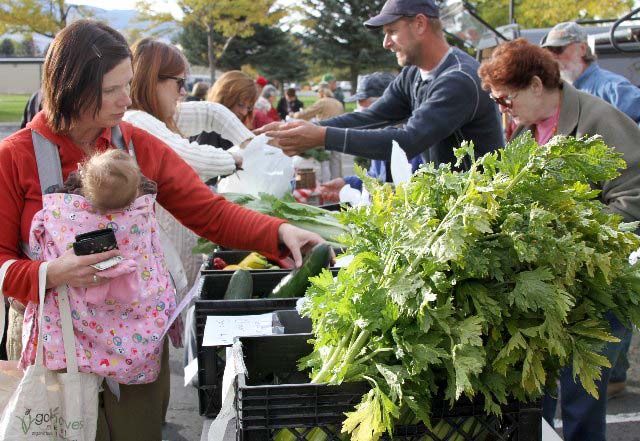
Cody resident Amy Quick browses produce offered by Shoshone River Farm at a farmers' market in Cody, Wyo. (Elijah Cobb - click to enlarge)
By Ruffin Prevost
CODY, WYO. — In the early decades of the last century, many of the hotels inside Yellowstone National Park kept their own dairy cows and chickens on site during the summer, providing fresh milk, butter and eggs to guests. Visitors enjoyed locally raised Yellowstone food from an environment as pristine as any farm in the world.
Then, visitation to the park dipped during the Great Depression and World War II, and Yellowstone’s habitat and wildlife management policies changed. Roads and delivery trucks improved, so food production left the park, said Bob Richard, a Cody, Wyo. tour guide who has worked previously as a mounted ranger in Yellowstone.
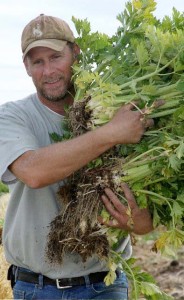
Farmer Scott Richard of Cody, Wyo. supplies organic produce to local restaurants. (Elijah Cobb - click to enlarge)
But that doesn’t mean today’s visitors to Yellowstone and Grand Teton national parks can’t get great local food in the parks and in gateway communities. A growing list of farmers and ranchers — including Richard’s son, Scott Richard — are using a mix of old ways and new techniques to supply sustainably produced food to travelers who crave authenticity and quality. Premiere purveyors in the parks are helping to drive a local sustainable food movement that allows small producers to grow their businesses and maintain agricultural production across Yellowstone country.
“This thing has really just taken off,” Bob Richard said by cell phone from atop a tractor at his son’s Shoshone River Farm, where he helps Scott try to meet an ever-growing demand from area residents and visitors eager to eat local food. “People really like fresh, homegrown produce.”

Click to read more stories from our Stay Green in the Parks series on sustainable dining and loding in Yellowstone and Grand Teton.
They also like fresh, locally raised meat, cheese, fish and other foods. Especially while touring a premier national park, visitors expect their food to be produced and served in a way that is sustainable and in harmony with the environment, said Lu Harlow, director of food and beverage operations for Yellowstone concessioner Xanterra Parks and Resorts.
“We are under a magnifying glass for everything we do here in a national park,” said Harlow, who buys nearly a third of Xanterra’s food and beverages from sustainable producers. That’s a challenge in an area with few people and little in the way of fine dining.
Each year, Xanterra serves 6,000 pounds of bison tenderloin, 6,300 pounds of ground elk and 70,000 pounds of natural prime rib. Harlow works with the nonprofit Western Sustainability Exchange, where she is an advisory board member, to find local sources for much of that food, including lamb from producers Barb and Per Gunness.
“The whole idea that we’ve been supplying in the park as long as we have helps us sell and get new clients all the time,” said Barb Gunness, whose Wolf Ridge Lamb and Wool, of Pray, Mont., has supplied natural Icelandic lamb to Xanterra for more than five years.
After meeting Harlow at a networking event sponsored by WSE, Gunness has seen her sheep ranching business grow to the point where she is close to meeting her long-term goal for maximum production.
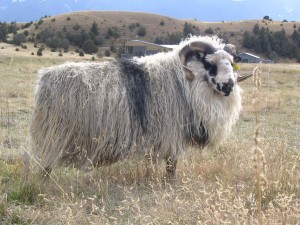
Wolf Ridge Lamb and Wool supplies icelandic sheep to Yellowstone Park concessioner Xanterra Parks and Resorts for lamb dishes served in park dining rooms. (courtesy photo - click to enlarge)
“We started off the first year just doing a special at the Lake Hotel,” Gunness said. “It went really well, then it just kept growing from there.”
Xanterra has steadily increased its purchases for Yellowstone food service, and is “really trying to use every part of our lambs as possible,” she said. The company sells more legs and chops in the summer and has begun using shoulders in the winter.
The result has been a steady source of year-round income that lets Wolf Ridge plan and grow its small family business. That also helps more than a dozen interdependent local businesses north of Yellowstone, Gunness said, from the meat packer to the yarn shop.
“The businesses that benefit from this is just incredible. We help run each others’ lives,” she said.
Wolf Ridge and other producers working with WSE follow sustainable practices like avoiding or using a minimum of hormones, antibiotics, pesticides and chemical fertilizers. They also take a hands-on approach to working with customers — Wolf Ridge personally delivers its lamb to Xanterra — and they are always looking for innovative ways to improve their operations.
Melvyn and Sue Brown started Amaltheia Dairy, in Belgrade, Mont., 11 years ago as a commercial goat cheese operation. But in an effort to get the most of all that’s produced on the property, they later added an organic pork enterprise, feeding the pigs excess whey left over from cheese production. They supply 1,700 pounds of sustainably produced goat cheese to Xanterra Yellowstone each year for salads and other dishes. But Amaltheia’s products are not just used in Yellowstone dining rooms, they’re also sold in stores throughout the park.
Being a supplier to Yellowstone Park has helped Amaltheia in its direct retail sales from its web site and in retail channels via distributors to major urban markets in places like Seattle, San Francisco and New York.
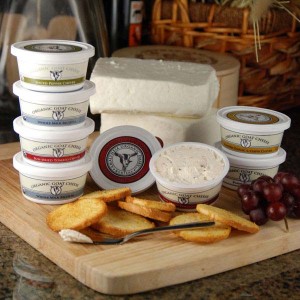
Montana's Amaltheia Dairy supplies goat cheese to restaurants and stores in Yellowstone Park, which helps in marketing its products nationwide. (courtesy photo - click to enlarge)
“It’s been great. We don’t know anybody that doesn’t love Yellowstone,” Melvyn Brown said.
Like Wolf Ridge, Amaltheia’s organic goat cheeses first showed up about five years ago as a special menu item at the Lake Hotel. Since then, they’ve become staples in a variety of Yellowstone food items. Brown said the summer spike in demand from Xanterra follows the spring kidding season so it “boosts our sales at a time when we need it, and the extra milk gets used up in the park.”
“It benefits us greatly,” he said.
Those benefits ripple throughout the region, as producers keep land in agricultural production and maintain family businesses and jobs with strong ties to the region’s distinct character, said Lill Erickson, executive director of theWestern Sustainability Exchange.
The Livingston, Mont. nonprofit group helps connect food producers with restaurants and other food outlets as part of its goal to “maintain the environmental quality and cultural integrity of the region by increasing the viability of farmers and ranchers using sustainable practices,” she said. The exchange also promotes restaurants using sustainably produced foods, helping to spur demand for the products.
“We find that the outlets that do best are flexible and willing to experiment with us on testing out a product, or testing it in smaller quantities, then building up” as supplies become available, Erickson said.
Around Grand Teton National Park and Jackson, Wyo., a more affluent population and busier high-end dining market have long made it easier than in neighboring areas to find organic and sustainably produced products. But chefs there are now focusing more than ever on local foods.
Vendors like Wyomatoes, a tomato grower in Big Piney, Wyo., are a favorite with chef Kevin Humphreys, whose Cascade restaurant in Teton Village, Wyo. serves them in salads and a signature fried green tomato sandwich. Humphreys also buys from Teton Valley Creamery in Driggs, Idaho and Mead Ranch in Jackson Hole, Wyo.
Growing a great tomato can be tough enough under ideal conditions, but can become almost impossible during a poor weather year in Wyoming. Farmer Scott Richard, of Cody, Wyo., learned that during the past two years, when cold and cloudy early summers shortened the region’s already brief growing season.

Caterer Donni Hall and granddaughter Grace shop at a farmers' market in Cody, Wyo. (Elijah Cobb - click to enlarge)
“Most of my customers understand,” said Richard, whose Shoshone River Farm supplies produce to local restaurants around Cody, including the Wyoming Rib and Chop House and Willow Fence Tea Room. “I make no promises. The idea is I call them the week before I pick.”
Like Erickson, Richard said things work best when buyers can scale back a regular produce order from a major food service vendor as his goods are harvested.
Richard got his start selling to restaurants when the Sunset House in Cody was having trouble getting tomatoes during a 2008 shortage caused by a salmonella outbreak. He has expanded his operation for each of the last four years, adding greenhouses and additional farmland, but still struggles to meet demand.
Richard credits support from restaurants and even local grocery stories in Cody and Powell, Wyo. with keeping him going, along with a growing list of customers in his community supported agriculture program and at the Cody farmers’ market.
“It’s growing, but it’s certainly not there yet,” said Richard, who practices biodynamic farming, a sustainable, organic method that focuses on using manure and natural soil amendments over chemical fertilizers and pesticides.
He said the local farmers’ market has grown “exponentially” in the last year, and “people in Wyoming are starting to become aware of the possibilities and are willing to maybe pay that little extra amount for the costs associated” with sustainable food production.
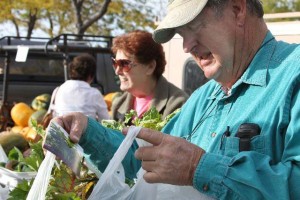
Bob and June Richard help out at a farmers' market in Cody, Wyo. selling produce raised by their son, Scott Richard, owner of Shoshone River Farm. (Elijah Cobb - click to enlarge)
Richard’s farm has even attracted volunteers devoted to his cause, including his parents. Father Bob Richard was a Yellowstone Park ranger from 1956-60 and now works as a photographer and tour guide in and around the parks.
For Richard, who shares stories with his tour clients about the chicken and dairy operations from Yellowstone’s earlier days, it’s an obvious point of pride to see his son’s farm grow.
“Of course I’m proud,” he said. “But I’ve told Scott, ‘You’re going to have to find more volunteers like me and your mother, or else hire some people.’ Probably both.”
Contact Ruffin Prevost at 307-213-9818 or ruffin@yellowstonegate.com.
